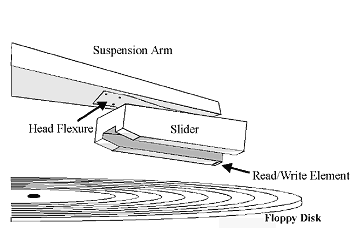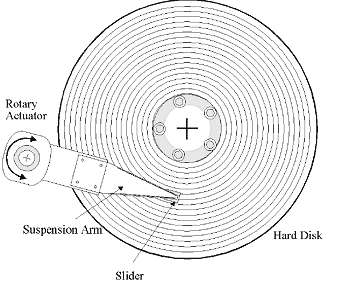 |
 |
| HOW A FLOPPY DISK READS & WRITES INFORMATION | ||
| QUESTIONS OR COMMENTS | ||
 |
AUTHOR: | Michael Ramirez |
| E-MAIL: | marekim@MIT.EDU | |
| COURSE: | 2 | |
| CLASS/YEAR: | 2 | |
MAIN FUNCTIONAL REQUIREMENT: To transfer information between computer and floppy disk tracks.
DESIGN PARAMETER: Floppy Disk Drive Read Write Elements
GEOMETRY/STRUCTURE:
 |
| Position of Read Head Relative to Disk Track |
 |
| Read Write Element Used To Read A Floppy Disk |
 |
| Top View of Disk Reading Mechanism |
Photo A courtesy of: Accurite Technologies; http://www.accurite.com/FloppyPrimer.html
Photos B & C courtesy of: Center for Magnetic Recording Research at
University of California, San Diego; http://talke08.ucsd.edu/index/disk.html
EXPLANATION OF HOW IT WORKS/ IS USED:
When the floppy disk drive is first powered up, the rotary actuator and the index sensor both work together to place the read/write heads over track 0 (starting track on a floppy disk). Once the sensor has reached this starting track, the computer is now ready to retrieve or write files onto the floppy disk.
The read/write heads are precise instruments, and head misalignment is a common problem in many floppy disk drives. The radial positioning of the head is the most common type of misalignment. By radial, it means that the head is displaced along the radius of the disk. The head is considered out of specification if it is displaced from the nominal standard more than +/- 600 millionths of an inch. Another type of misalignment which occurs in floppy disks concerns the azimuth of the head, which is the angular alignment on its vertical axis. These two alignment factors are critical in reading and writing onto disks, because if either the radial or azimuth are off specification, floppy disks which have received information from this drive may be unreadable on other drives.
As the drive begins to receive information from the computer, or from the disk when retrieving files, the rotary actuator moves the suspension arm out track by track depending on the number of step signals it receives from the computer system. The floppy drive system is blind, and relies on these signals to place it over the correct track on the floppy disk. If one of the above mentioned misalignments occurs, the magnetic head wouldn’t know any better, and therefore would read/write information in the wrong place. The heads are spring loaded using a head flexure to help them stay in physical contact with the spinning disk.The motor spindle is probably one of the most important parts in the reading and writing process of a floppy disk drive. It serves as an indicator of the spinning disk's speed, which is expressed in revolutions per minute. The spindle must rotate the disk at 300 RPM to be sure the recorded data will arrive at the floppy controller with the correct frequency. If the disk spins too slow, the frequency will be too low, and would be unreadable by the magnetic floppy disk. If the motor were to spin too fast, the frequency would be too high, and when information is being written, the writer would not be able to store all the information necessary on the given track after one revolution.
DOMINANT PHYSICS:
The information retrieved and written onto a floppy disk is controlled by the process of magnetic encoding. As the read/write head passes over designated tracks of the floppy disk it uses magnetic polarization to write information onto the disk, and to retrieve this information. In the reading and storing of data, the head uses the binary numbers 0 and 1 which correspond to the north and south poles of a magnet. Being that these two components (the read/write head and the floppy disk) are both magnetized, the computer sends either a positive or negative voltage to the head which encodes this into a series of 0's and 1's corresponding to north and south. The opposite process is done when the head is reading information. The head picks up a signal from magnetized parts of the disk and the read/write head, and sends the information to the computer, converting the charges to binaries.
LIMITING PHYSICS:
None Submitted
PLOTS/GRAPHS/TABLES:
None Submitted
WHERE YOU CAN FIND FLOPPY DISK DRIVES:
Floppy disk drives are generally standard equipment for most personal computers, but with the now common use of CD ROM drives, newer desktops and laptops are missing floppy disk drive technology. If a computer does not have a floppy disk drive, an internal or external drive could be bought separately.
REFERENCES/MORE INFORMATION: